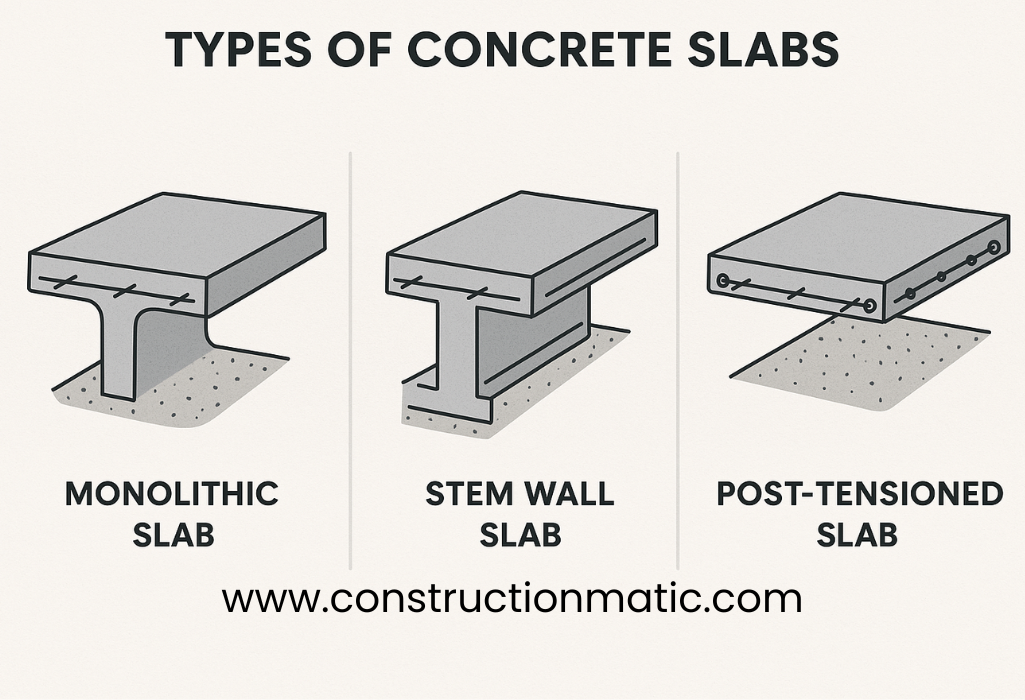In this guide, we’ll break down the three most common types of concrete slabs used in residential and light commercial construction: monolithic slabs, stem wall slabs, and post-tensioned slabs.
🧱 1. Monolithic Slab (Slab-on-Grade)
A monolithic slab is a single-pour concrete system where the footing and slab are poured at the same time. It’s also called a slab-on-grade foundation.
🔨 Key Features:
- Footings are integrated into the slab
- Typically 12″ thick at the perimeter and 4″ thick in the middle
- Reinforced with rebar or welded wire mesh
📍 Best Used For:
- Flat, stable soil conditions
- Detached garages, sheds, driveways, and many single-story homes
✅ Pros:
- Faster and more affordable to construct
- Less excavation required
- Good for warmer climates (no frost line issues)
⚠️ Cons:
- Not ideal for sloped lots
- Limited insulation and plumbing access
- Lower resistance to shifting soil or freeze-thaw cycles
🧱 2. Stem Wall Slab
A stem wall slab is a two-part system where a short concrete or block wall (the stem wall) is constructed first on top of footings, and then the slab is poured inside it.
🔨 Key Features:
- Footings and stem wall are poured separately
- Slab is independent and often thicker than monolithic
- Allows for elevation and crawlspace access
📍 Best Used For:
- Sloped lots or uneven terrain
- Homes requiring elevated floors
- Areas with expansive or shifting soils
✅ Pros:
- Better structural integrity on unstable ground
- Allows for plumbing and electrical access
- Easier to insulate and waterproof
⚠️ Cons:
- Requires more time and labor
- Higher cost than monolithic slabs
- May require additional fill material
🧱 3. Post-Tensioned Slab
A post-tensioned slab is a specialized slab-on-grade that uses high-strength steel cables (tendons) stressed after the concrete is poured to add tension and structural integrity.
🔨 Key Features:
- Concrete is poured with embedded sheathed cables
- Cables are tightened (post-tensioned) after curing
- Often used in engineered slab-on-grade systems
📍 Best Used For:
- Expansive clay soils
- Multi-family buildings or large residential homes
- Sites with limited access to deep footings
✅ Pros:
- Highly resistant to cracking and soil movement
- Uses less concrete overall
- Long spans without needing thick slabs
⚠️ Cons:
- Requires engineering and tensioning equipment
- Not suitable for DIY or casual contractors
- Post-construction modifications are challenging

📊 Comparison Table
| 🔧 Feature | 🧱 Monolithic Slab | 🏗️ Stem Wall Slab | 🚧 Post-Tensioned Slab |
|---|---|---|---|
| 📍 Construction Steps | One pour (slab + footing) | Footing → Wall → Slab | Pour slab → Tension later |
| 🧩 Soil Compatibility | Stable soils only | Works on sloped/unlevel | Best for expansive soils |
| 🛠️ Labor & Equipment | Basic tools | Moderate labor | Specialized equipment |
| 💰 Cost | $ | $$ | $$$ |
| 🔧 Engineering Required | No | Sometimes | Always |
| 🔍 Post-Modification | Easy | Easy | Difficult |
🔍 Choosing the Right Slab for Your Project
Selecting the correct slab type isn’t just about budget—it’s about matching the slab to site conditions, intended use, and code requirements. Here’s a quick rule of thumb:
- Use monolithic slabs for quick builds on flat land with stable soil
- Choose stem walls when you need elevation, crawlspace access, or slope adaptability
- Opt for post-tensioned slabs in engineered builds or high-risk soil zones
Always consult a structural engineer or local building official when in doubt.
✅ Summary
| Slab Type | Best For |
|---|---|
| Monolithic | Affordable, fast builds on flat, stable lots |
| Stem Wall | Structural strength on slopes or bad soils |
| Post-Tensioned | High-performance slabs on unstable ground |
Each slab type serves a specific purpose in residential construction. With proper planning and design, you can choose the one that ensures a stable, long-lasting foundation for your structure.
Let Constructionmatic help with your slab estimates and structural planning. Stay tuned for calculator tools and more guides!